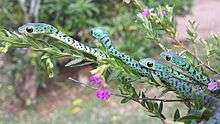Philothamnus semivariegatus
| Philothamnus semivariegatus | |
|---|---|
| | |
| Philothamnus semivariegatus, Soutpansberg, South Africa | |
 | |
| | |
| Scientific classification | |
| Kingdom: | Animalia |
| Phylum: | Chordata |
| Class: | Reptilia |
| Order: | Squamata |
| Suborder: | Serpentes |
| Family: | Colubridae |
| Genus: | Philothamnus |
| Species: | P. semivariegatus |
| Binomial name | |
| Philothamnus semivariegatus (A. Smith, 1840) | |
| Synonyms | |
Philothamnus semivariegatus, commonly known as the spotted bush snake, is a species of non-venomous colubrid snake, endemic to Africa.
Geographic range
P. semivariegatus is distributed from South Africa northward to Sudan,Uganda and from Guinea eastward to Tanzania.[2]
Description
The colour is bright green with black speckles. Average snout to vent length (SVL) is 60–90 cm (24–35 in).
Biology
Spotted bush snakes are mostly found in trees in bush and forest areas, where they hunt lizards and treefrogs. They are excellent climbers and swimmers, have very good eyesight, and are highly alert snakes. They are not territorial, and will roam great distances in search for food. Spotted bush snakes are very common and completely harmless. They are well camouflaged, naturally very nervous, and quick to escape from any potential threat. As such, suburban sightings are rare.
In captivity
They cannot be kept as pets or even bred in enclosed serpentariums, and are reluctant to feed in captivity.
Reproduction
Females can lay between 3 and 12 elongate eggs every summer, and each hatchling is about 25 cm (9.8 in) in total length (including tail).
References
- ↑ Boulenger GA. 1894. Catalogue of the Snakes in the British Museum (Natural History). Volume II., Containing the Conclusion of the Colubridæ Aglyphæ. London: Trustees of the British Museum (Natural History). (Taylor and Francis, printers). xi + 382 pp. + Plates I- XX. (Philothamnus semivariegatus, pp. 99-100).
- ↑ The Reptile Database. www.reptile-database.org.
- Branch, Bill. 1988. Field Guide to the Snakes and other Reptiles of Southern Africa. ISBN 0-86977-641-X.
Further reading
- Branch, Bill. 2004. Field Guide to Snakes and Other Reptiles of Southern Africa. Sanibel Island, Florida: Ralph Curtis Books. 399 pp. ISBN 0-88359-042-5. (Philothamnus semivariegatus, pp. 93–94 + Plates 30, 99).
- Smith, Andrew. 1840. Illustrations of the Zoology of South Africa ... London: Lords Commissioners of Her Majesty's Treasury. (Smith, Elder and Co., printers). (Dendrophis semivariegata, Plates LIX, LX, LXIV, Figure 1).